Lichens are symbiotic organisms composed of fungi and algae or cyanobacteria. Despite their simple appearance, lichens play a significant role in the economy and contribute to several industries. The present article discusses the Economic Importance of Lichens. Here we will discuss both the beneficial and harmful aspects of lichens.
Learn more: General Characters of Lichen
Economic Importance of Lichens
The economic importance of lichens can be divided into two broad categories- (A). Beneficial Aspects and (B). Harmful Aspects.
(A). Beneficial Economic Importance of Lichens
(1). Ecological Importance of Lichens
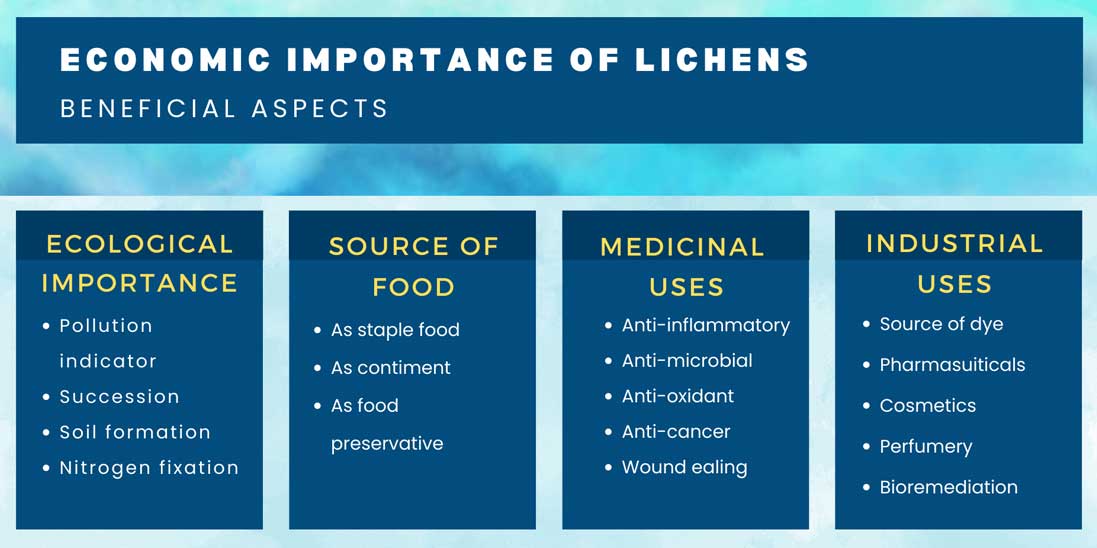
Lichens plays crucial roles in the ecology; it serves as a crucial component of many ecosystems. Some of the key ecological roles of lichens include:
Ø Lichens are indicators of pollution-free environment: Since lichens are very sensitive to environmental changes (pollution), their presence in an area indicate a pollution free environment. Lichens cannot survive in the areas air pollution due to sulphur dioxide occurs. Thus, lichens can act as indicator species for monitoring air quality and other environmental parameters.
| You may also like NOTES in... | ||
|---|---|---|
| BOTANY | BIOCHEMISTRY | MOL. BIOLOGY |
| ZOOLOGY | MICROBIOLOGY | BIOSTATISTICS |
| ECOLOGY | IMMUNOLOGY | BIOTECHNOLOGY |
| GENETICS | EMBRYOLOGY | PHYSIOLOGY |
| EVOLUTION | BIOPHYSICS | BIOINFORMATICS |
Ø Lichens are pioneer of ecological succession: Lichens are the first seral community (pioneer community) in a xerarch succession. Example: Caloplaca and Lecanora
Ø Lichens assists in soil formation: Lichens release lichen acids which help in the weathering of rock and organic matter that leads to the formation of soil.
Learn more: Ecological Succession
Ø Lichens can fix atmospheric Nitrogen: Lichen that contain cyanobacteria, are capable of fixing atmospheric nitrogen. Nitrogen fixation is essential for maintaining soil fertility.
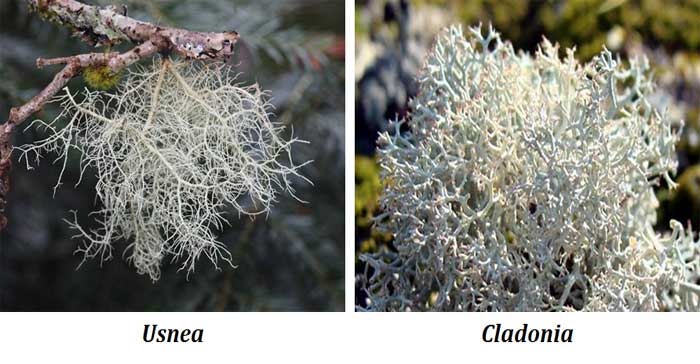
Ø Lichens act as food source to animals: Lichens are an important food source for a variety of animals, including reindeer, caribou, and some species of birds and insects. Example: Cladonia and Cetraria islandica
Ø Biodiversity: Lichens are a diverse group of organisms that contribute to the overall biodiversity of an ecosystem. They are found in a wide range of habitats, including forests, tundra, and even urban environments.
(2). Use of Lichen as Food for Man and Animals
Lichens have been used as a source of staple food, food colorant, and food preservative for centuries in some traditional cultures, particularly in arctic and sub-arctic regions. Some of the most common uses of lichens as food are listed below:
Ø In some cultures, lichens are used as a staple food and are collected, dried, and stored for later use.
Ø Reindeer moss (Cladonia rangiferina) is a common food source for indigenous peoples in the Arctic and is eaten either raw or cooked.
Ø The thallus of Umbilicaria has been eaten in arctic regions in danger of striation.
Ø Species of Lecanora have been used as food in Western Asia and Northern Africa.
Ø Parmelia is used as flavouring agent in some culinary preparations of South India.
Ø Some lichens are used as a flavor enhancer in some traditional dishes.
Ø Example: Iceland moss (Cetraria islandica) is used as a spice in Scandinavian and Icelandic cuisine.
Ø Some lichens are used as natural food colorants due to their bright and distinctive pigments.
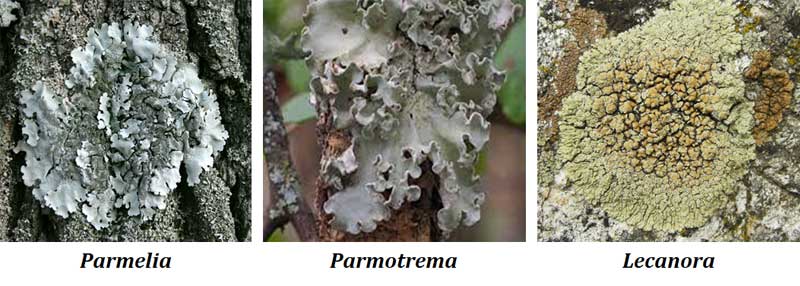
Ø Some lichens have antimicrobial properties, making them useful as natural food preservatives.
Ø Example: Usnic acid, extracted from Usnea, has been used to preserve cheese and other dairy products.
(3). Medicinal Importance of Lichens
Lichens also have been used for medicinal purposes for centuries in traditional medicine. Some of the most important medicinal uses of lichens are listed below:
Ø Anti-inflammatory: Some lichens contain compounds that have anti-inflammatory effects, making them useful in the treatment of rheumatoid arthritis and inflammatory bowel disease. Example Parmelia, Usnea
Ø Antimicrobial: Lichens contain a variety of antimicrobial compounds, including usnic acid and barbatic acid, which are effective against many pathogenic bacteria.
Ø Anti-oxidant activity: Experimental evidence suggested that barbatic acid (extracted from Usnea and Cladonia) has antioxidant properties.
Ø Anticancer: Some lichen compounds are promising for the treatment of various types of cancer, including breast and colon cancers.
Ø Example: Barbatic acid exhibits cytotoxic and genotoxic activity against some tumour cell lines and it has a pro-apoptotic property as well.
Learn more: Molecular Mechanism of Apoptosis
Ø Wound healing: Lichens have been used for wound healing in traditional medicine.
Ø Immune system booster: Lichens have been shown to have immunostimulatory effects, making them useful for boosting the immune system and preventing infections.
(4). Industrial Uses of Lichens
Lichens have a wide range of industrial uses, and their unique properties make them valuable in a variety of industries. Some of the most important industrial uses of lichens include:
Ø Lichens are good source of dyes: Lichens have been used for centuries as a source of natural dyes for textiles and other products.
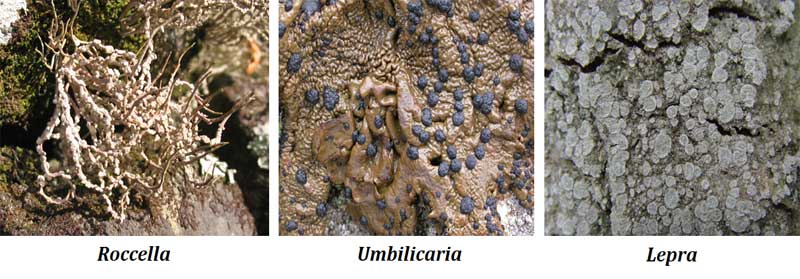
$. Example: Litmus is a pH sensitive dye extracted from many species of Roccella, Lepra, Parmotrema and Parmelia. Litmus is used to test the pH.
Learn more: pH of Water is 7, Why?
$. Orchil or Orcein is a bright purple dye extracted from Roccella tinctoria. Orchil is used to stain cloth and wood. Orchil can also stain chromosomes.
Learn more: Classification of Chromosomes based on Position of Centromere
$. Cudbear is a purple dye extracted from orchil lichens used for colouring wool and silk.
Ø Pharmaceutical and Cosmetics: Lichens have been used as an ingredient in cosmetics and personal care products due to their antimicrobial properties.
Ø Bioremediation: Lichens have been used in bioremediation, the process of using living organisms to clean up contaminated environments. Some lichen species are capable of breaking down toxic compounds, such as heavy metals, making them useful in the clean-up of contaminated sites.
Ø Perfumery: Some lichens produce fragrant compounds that have been used in perfumery for centuries. For example, oakmoss (Evernia prunastri), a lichen that grows on oak trees, is a common ingredient in perfumes and fragrances.
(B). Harmful Aspects of Lichens
While lichens play an important role in many ecosystems and have a wide range of industrial, medicinal, and ecological uses, they can also have harmful effects in some situations. Some of the most notable harmful aspects of lichens include:
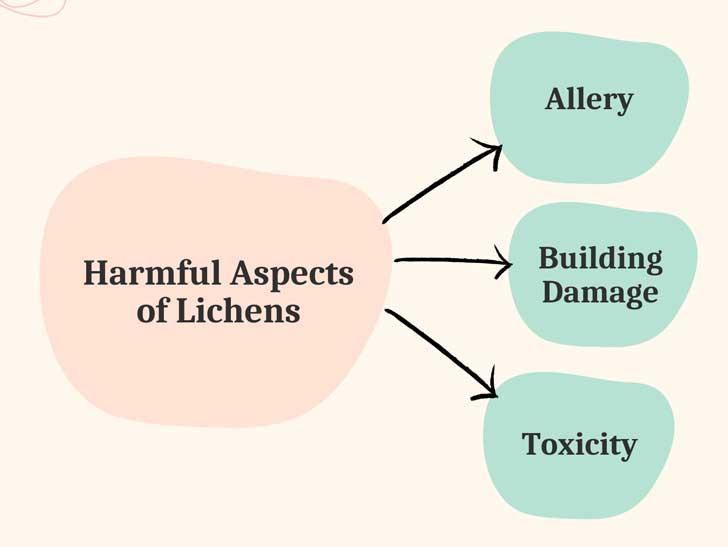
Ø Allergic reactions: Some people can develop allergic reactions to lichens, especially when they are exposed to large amounts of airborne lichen spores. Symptoms of lichen allergies can include itching and sneezing.
| You may also like... | ||
|---|---|---|
| NOTES | QUESTION BANK | COMPETITIVE EXAMS. |
| PPTs | UNIVERSITY EXAMS | DIFFERENCE BETWEEN.. |
| MCQs | PLUS ONE BIOLOGY | NEWS & JOBS |
| MOCK TESTS | PLUS TWO BIOLOGY | PRACTICAL |
Ø Toxicity: Some lichen species contain toxic compounds, such as usnic acid, which can be harmful to humans and animals if ingested in large amounts. Ingestion of toxic lichens can cause a range of symptoms, including vomiting, diarrhea, and respiratory distress.
Ø Building damage: Some lichens can cause damage to buildings and other structures if they are allowed to grow unchecked. For example, lichens can break down roofing materials, cause discoloration of paints
<<< Back to LICHEN Notes Page
Dear readers
I hope you have enjoyed reading this article and finding the content informative. We believe that this article helped you to understand the Economic Importance of Lichens. I would like to take this opportunity to request your COMMENTS on the topics I have covered. Whether you have a suggestion, a question about the topic, or simply want to share your thoughts, I would love to hear from you. Your comments provide me with the opportunity to engage in meaningful discussion and continue to write with the best possible content in Biology.
So, please don’t hesitate to leave a comment below. I appreciate your support and look forward to hearing from you.
Best regards, [Admin, EasyBiologyClass]
